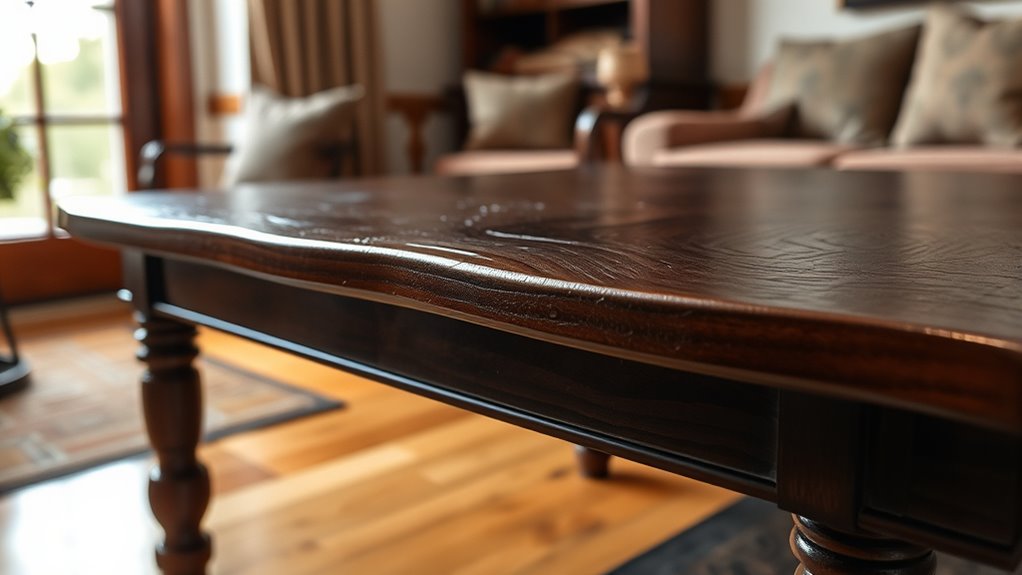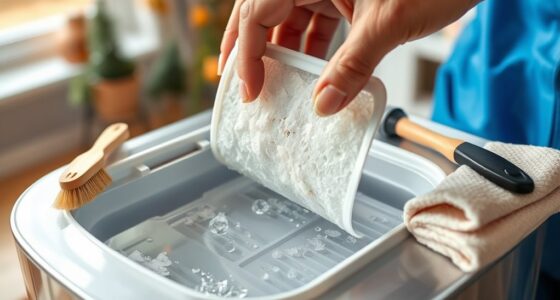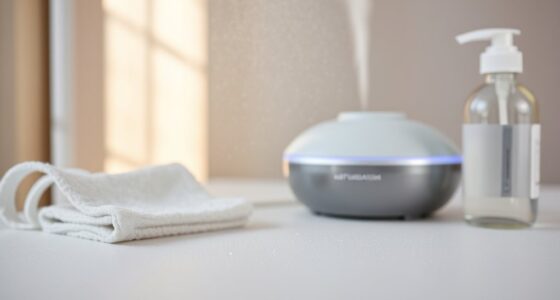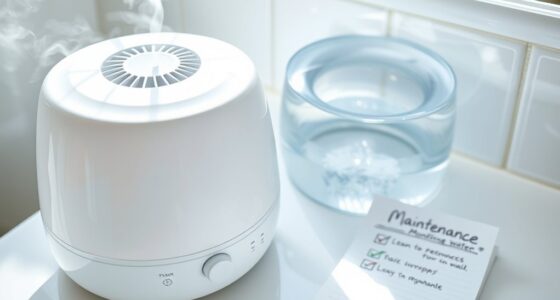High humidity causes your wooden furniture and floors to absorb moisture, making them swell, warp, or buckle over time. In contrast, low humidity makes wood dry out and shrink, causing cracks, gaps, and loose joints. Maintaining a balanced indoor humidity level between 40-60% helps prevent these issues and preserves your wood’s appearance and stability. If you want to learn more about how to protect your wood investments, keep exploring the key strategies.
Key Takeaways
- High humidity causes wood to absorb moisture, leading to swelling, warped furniture, and buckled floors.
- Low humidity causes wood to lose moisture, resulting in cracks, splits, and loose joints.
- Maintaining indoor humidity between 40-60% prevents damage from expansion and contraction.
- Fluctuating humidity levels can weaken wood structure over time, causing long-term damage.
- Proper climate control and monitoring help preserve the appearance and durability of wooden furniture and floors.
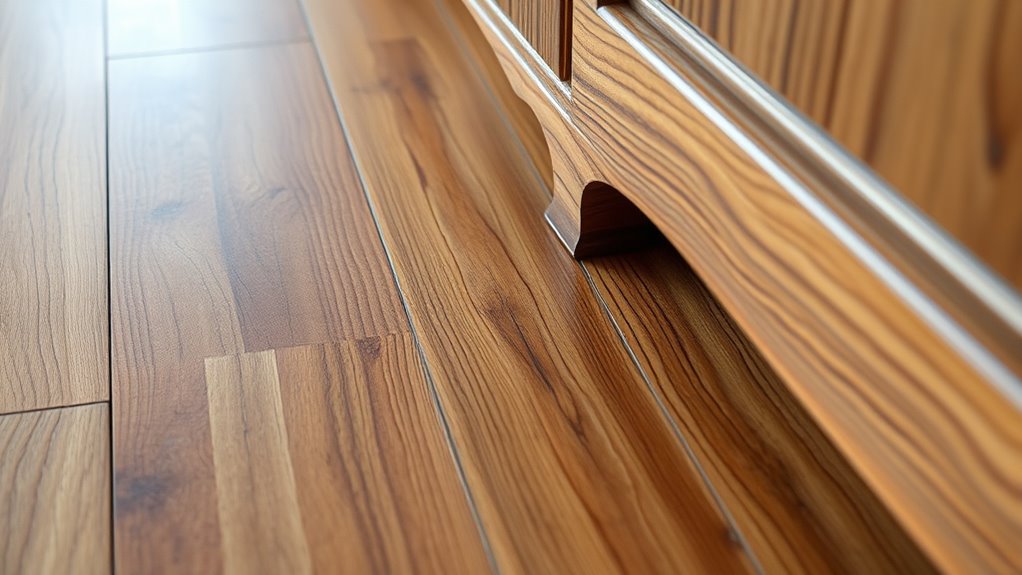
Maintaining proper indoor humidity is vital for preserving the beauty and integrity of wooden furniture. When humidity levels fluctuate, your wood pieces are directly affected, especially through processes like wood expansion and moisture absorption. Wood naturally responds to the environment around it; when the air is humid, it absorbs moisture from the atmosphere, causing it to swell or expand. Conversely, in dry conditions, wood releases moisture and contracts, which can lead to cracks, splits, and warping. Understanding this delicate balance helps you take better care of your furniture and floors.
Proper indoor humidity preserves wood furniture by preventing expansion, contraction, and damage caused by moisture fluctuations.
If your home’s humidity is too high, your wooden furniture will absorb excess moisture. This moisture absorption causes the wood to expand, which might seem harmless at first but can quickly lead to issues like swollen drawers, misaligned doors, or warped tabletops. Over time, the repeated cycle of moisture absorption and release weakens the wood’s structure, making it more susceptible to damage. Floors also suffer from this as moisture causes the planks to expand, sometimes pushing against each other and creating gaps or buckling. These changes distort the original shape and appearance of your furniture and flooring.
On the flip side, when indoor humidity drops too low, the wood begins to lose moisture. This causes it to contract or shrink, which can lead to cracks, splits, and loosened joints. You might notice gaps forming between planks or within furniture joints, compromising the stability and look of your pieces. This contraction not only damages the wood’s surface but can also make furniture more fragile over time. Floors may also separate or develop creaks as the wood shrinks away from neighboring planks, diminishing the overall aesthetic of your space.
To prevent these issues, maintaining a balanced indoor humidity level—generally between 40% and 60%—is vital. Using a humidifier during dry months or a dehumidifier when the air is too moist can help regulate moisture levels. Additionally, keeping your home at a consistent temperature and avoiding rapid changes in climate will minimize the wood’s natural response to moisture fluctuations. Regularly inspecting your furniture and floors for signs of expansion or contraction allows you to address problems early, preventing long-term damage.
Strategic climate control and understanding the effects of humidity on wood are key to ensuring your furniture and floors stay beautiful, functional, and durable for years to come.
Frequently Asked Questions
How Does Humidity Affect Different Types of Wood Finishes?
Humidity influences how different wood finishes respond over time. High humidity can cause wood sealants to weaken, leading to finish deterioration, while low humidity might cause finishes to crack or peel. You should maintain consistent indoor humidity levels to protect your furniture. Properly applied finishes, suited for your environment, help preserve the wood’s beauty and durability, ensuring your furniture stays looking great longer.
What Are Signs of Humidity Damage on Wooden Furniture?
You might notice subtle signs of humidity affecting your wooden furniture, like slight wood swelling that gives a soft, rounded look or finish peeling that hints at moisture issues. These signs indicate your wood is absorbing excess humidity, causing it to expand and the finish to loosen. Keep an eye out for these gentle changes, and address humidity levels to protect your furniture’s beauty and longevity.
Can Indoor Humidity Levels Be Too High for Wood?
Yes, indoor humidity levels can be too high for wood. When humidity is excessive, your wooden furniture and floors absorb moisture, leading to wood expansion. This moisture absorption causes swelling, warping, and potential damage over time. To protect your wood, maintain indoor humidity between 30-50%. Using a dehumidifier helps control moisture levels, preventing excessive expansion and preserving the integrity of your wooden items.
How Quickly Does Humidity Change Impact Wood?
Think of your wood as a sensitive friend who reacts to change. When humidity fluctuates, it quickly feels the difference, causing rapid wood expansion or moisture absorption. You might notice this within days—furniture and floors could swell or contract as your environment shifts. Keeping a steady humidity level helps your wood stay calm and stable, preventing those unwanted surprises and preserving its beauty over time.
Are Certain Rooms More Vulnerable to Humidity Damage?
Certain rooms are more vulnerable to humidity damage due to room-specific moisture levels and seasonal humidity variation. For example, kitchens and bathrooms experience higher moisture, increasing risk for wooden furniture and floors. In contrast, rooms with less exposure to moisture, like bedrooms or living rooms, tend to be less affected. You should monitor and control humidity in these vulnerable spaces, especially during seasonal shifts, to protect your wood surfaces effectively.
Conclusion
So, next time you ignore that hygrometer or neglect to run a dehumidifier, remember—you’re basically inviting your precious wooden furniture and floors to throw a moisture tantrum. Who needs stability and longevity when you can enjoy the thrill of warped, cracked, or swollen wood? Keep humidity in check, or face the delightful chaos of your once-beautiful furniture turning into a DIY modern art installation. Cheers to moisture management—because your wood deserves better than a soggy soap opera.
